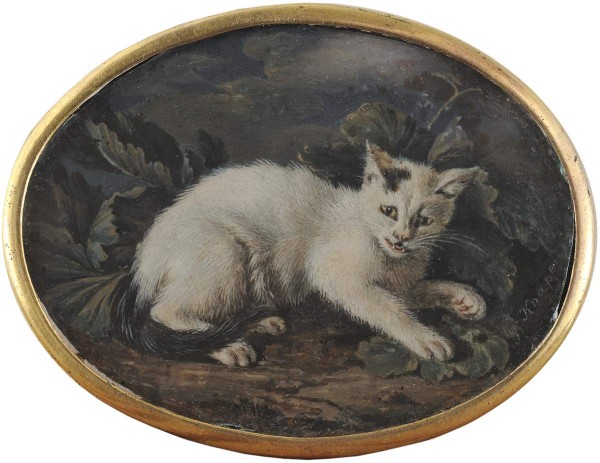The artist is KNAPPE

+ About the restoration of the work
– Hide the text about restoration
The state of safety before restoration:
Picturesque miniatures on parchment, paper, bones and metal occupy a special place in the work department of the restoration of mixed painting. Working with them is difficult not only because of the size of the painting, but also because of the use of various combinations of the foundations and colorful layers. As a rule, all foundations for such painting respond to the slightest changes in the temperature and humidity regime, lighting, mounting method. Therefore, even a preventive restoration and correct storage conditions are very important. Superficial pollution and bioporations often almost completely destroy the colorful layers of miniatures. A large number of losses in comparison with a small size of the originals are forced to use in each case a special approach to restoring losses.
Miniatures on the bones of the “cat” and “portrait of the military with the Maltese cross” were very deformed. The bone plates on which they were written were sealed on the back of a strong dark brown glue and numerous paper braces with inscriptions and numbers. The bone, which usually responds to the slightest changes in the temperature and humidity of the air, was glued with aqueous solutions, which was the main cause of destruction. Deformations of the back side caused the detachment and peeling of colorful layers on the front side. In the miniature “cat”, strong superficial contaminants, traces of biocation, loss and scuffs were visible. On the “military portrait” there were a large number of losses comparable in size with a tiny image of a gentleman.
Complex of the events:
Strengthening colorful layers on emergency sites on the front side was performed under a microscope. Adhesive compounds were selected in the process of trial work. The main requirement was the absence of changes in the color and appearance of halos and fuckers.
Then the back sides were cleared of thick tanks of dark glue. The work was carried out by very small areas in a “dry way”. Glue gradually grinded until completely cleaned. After that, the bone plates were straightened. For this, miniatures were placed in a camera in which there was a vessel filled with water. Exverting time and the number of water vapor in the chamber were selected experimentally. In the process, control over the state of the front side was very important, t.to. Some colorful mixtures and their combinations, the presence of varnishes in the binders can respond to moisture and, as a result, clutch, dissolve, mixing with the underlying layer. After repeated and gradual moisture and endurance, the bone foundations were straightened in the plane with a gradual increase in load. Pollution and traces of bioporations were removed mechanically. Under the microscope, restoration was completed by tinting and mounting in special glasses for glass. All inscriptions and numbers are transferred to a cardboard that protects the back side. Due to the large number of losses on the “military portrait with the Maltese Cross” in accordance with the decision of the restoration commission, tinting losses were carried out in a conditional manner, Pointer.
Keeping a story. Restoration workshop of the Russian Museum – 100 years. SPb, 2022. With. 154-155.
Leave a Reply